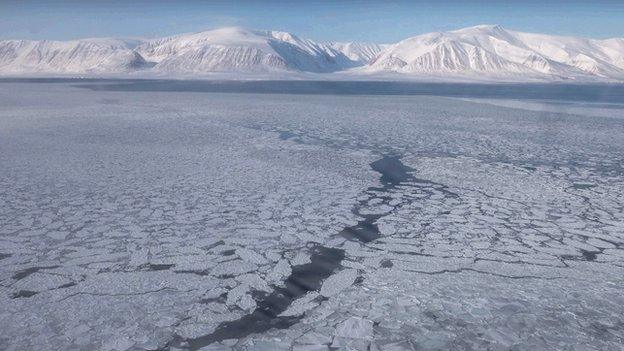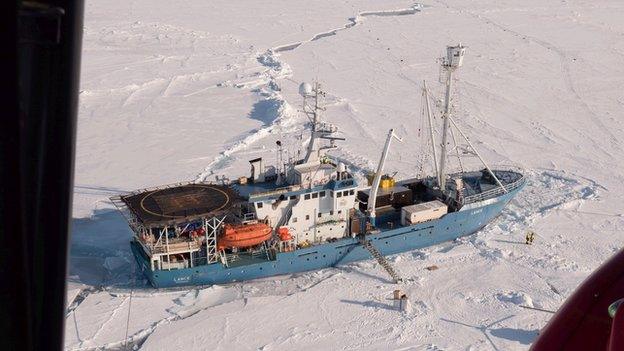Arctic mission monitors ice shift
- Published
- comments
David Shukman looks at the difficulties of doing scientific research in the Arctic
A highly unusual expedition is under way in the Arctic Ocean where a research vessel has been parked in the ice all winter.
Run by the Norwegian Polar Institute, the mission is exploring the big questions of how the region is changing and what this means for the ice and the wildlife.
This matters because the Arctic is on course to switch at some point this century from having permanent ice-cover to existing in a state where the ice comes and goes with the seasons.
That could open up everything from new shipping lanes to untapped oil and gas fields, and could also alter weather patterns far to the south as well.
A converted fishing vessel, the Lance is now a floating laboratory and the crew and researchers on board have been experiencing the rigours of science in one of the most hostile environments on Earth.
I was given a rare invitation to visit this research outpost five hundred miles from the North Pole, and cameraman Rob Magee, producer Mark Georgiou and I reached the ship after a spectacular journey.
Our starting point was the Arctic islands of Svalbard, which lie far to the north of Norway. There we were given floatation suits for a flight by helicopter out over the ocean.
Northern exposure
The journey took us through majestic fjords, some clear of ice but others choked with a patchwork of white and grey fragments.
At one point we passed an old Russian mining settlement, its abandoned buildings standing forlorn against the snow.
Jan-Gunnar Winther, director of the Norwegian Polar Institute, explains what the expedition is doing
After an hour, we crossed the final shoreline of some of the northernmost land on earth and headed out over the Arctic Ocean. If you could keep going from where we were, you would not meet land again until Siberia.
Our destination, the Lance, lay far ahead and, with a long way still to go, the helicopter needed to refuel so the pilots had made a rendezvous with a Norwegian coast guard patrol ship.

We touched down on its deck, the dark blue of the polar waters churning below, and, in the bitter cold, the crew's faces were almost invisible behind helmets and scarves.
The refuelling was carried out with military efficiency. If a country neighbouring the Arctic wants a presence in this region, it needs plenty of hi-tech muscle.
Next on our trek came a long stretch of open water, an area that would have been covered in ice in previous decades and only far in the distance could we see a band of mist marking the edge of the frozen ocean.
Go with the floe
Soon we crossed that boundary and were flying over an infinite expanse of white, the snow and ice sculpted into bumps and twists, occasional cracks dividing the floes, ridges showing where those floes had been forced together.
Then came a shout as someone spotted a flash of pale yellow fur bounding over the ice below us - a polar bear, on its own, lumbering but deceptively fast.
After nearly three hours of flying, a pale blue shape emerged from the dazzling landscape - it was the Lance, a lonely outpost of humanity jammed amid the ice at 83 degrees North.

A converted fishing vessel, the Lance is now a floating laboratory
As soon as we climbed out of the helicopter, the effect of the intense cold was stunning. The air temperature at that point was about minus 19C - it was like steeping into a freezer. With vigorous wind, it felt far more brutal.
Every breath produced a cloud of vapour and the sense of entering an icy realm was overwhelming.
A door was opened leading to the bridge and I was welcomed inside, our home for the next few days.